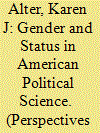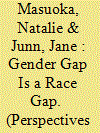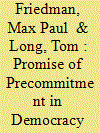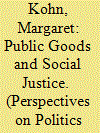|
|
|
Sort Order |
|
|
|
Items / Page
|
|
|
|
|
|
|
| Srl | Item |
| 1 |
ID:
175830


|
|
|
|
|
| Summary/Abstract |
What explains the alignment of antiabortion positions within the Republican party? I explore this development among voters, activists, and elites before 1980. By 1970, antiabortion attitudes among ordinary voters correlated with conservative views on a range of noneconomic issues including civil rights, Vietnam, feminism and, by 1972, with Republican presidential vote choice. These attitudes predated the parties taking divergent abortion positions. I argue that because racial conservatives and military hawks entered the Republican coalition before abortion became politically activated, issue overlap among ordinary voters incentivized Republicans to oppose abortion rights once the issue gained salience. Likewise, because proabortion voters generally supported civil rights, once the GOP adopted a Southern strategy, this predisposed pro-choice groups to align with the Democratic party. A core argument is that preexisting public opinion enabled activist leaders to embed the anti (pro) abortion movement in a web of conservative (liberal) causes. A key finding is that the white evangelical laity’s support for conservative abortion policies preceded the political mobilization of evangelical leaders into the pro-life movement. I contend the pro-life movement’s alignment with conservatism and the Republican party was less contingent on elite bargaining, and more rooted in the mass public, than existing scholarship suggests.
|
|
|
|
|
|
|
|
|
|
|
|
|
|
|
|
| 2 |
ID:
175831


|
|
|
|
|
| Summary/Abstract |
We investigate gender disparities in status construction in American political science, focusing on three questions: 1) Do institutions within the discipline of political science—including departments, APSA, editorial boards, and academic honor societies–reflect or remedy gender disparities that exist in many forms of recognition, including appointments to top leadership and citations? 2) Are institutions with centralized and accountable appointment mechanisms less gender skewed compared to networked and decentralized selection processes where implicit bias may go unchecked? 3) Does leaning in help? Does the effort of women to publish and to claim a seat at leadership tables increase the likelihood that higher-level status positions will follow? We find that the distribution of highest-status positions is still gender skewed, that women are over-represented in positions that involve more service than prestige, that “leaning in” by serving as section chair, on editorial boards, or on academic councils is not necessarily a gateway to higher-status appointments, and that accountability promotes greater gender parity. The study raises questions about the goal of gender parity when it comes to lower-status service, and about the types of contributions our discipline rewards.
|
|
|
|
|
|
|
|
|
|
|
|
|
|
|
|
| 3 |
ID:
175829


|
|
|
|
|
| Summary/Abstract |
A growing body of research shows that women legislators outperform their male counterparts in the legislative arena, but scholars have yet to examine whether this pattern emerges in non-policy aspects of representation. We conducted an audit study of 6,000 U.S. state legislators to analyze whether women outperform or underperform men on constituency service in light of the extra effort they spend on policy. We find that women are more likely to respond to constituent requests than men, even after accounting for their heightened level of policy activity. Female legislators are the most responsive in conservative districts, where women may see the barriers to their election as especially high. We then demonstrate that our findings are not a function of staff responsiveness, legislator ideology, or responsiveness to female constituents or gender issues. The results provide additional evidence that women perform better than their male counterparts across a range of representational activities.
|
|
|
|
|
|
|
|
|
|
|
|
|
|
|
|
| 4 |
ID:
175836


|
|
|
|
|
| Summary/Abstract |
Scholarship on women voters in the United States has focused on the gender gap, showing that, since the 1980s, women are more likely to vote for Democratic Party candidates than men. The persistence of the gender gap has nurtured the conclusion that women are Democrats. This article presents evidence upending that conventional wisdom. It analyzes data from the American National Election Study to demonstrate that white women are the only group of female voters who support Republican Party candidates for president. They have done so by a majority in all but 2 of the last 18 elections. The relevance of race for partisan choice among women voters is estimated with data collected in 2008, 2012, and 2016, and the significance of being white is identified after accounting for political party identification and other predictors.
|
|
|
|
|
|
|
|
|
|
|
|
|
|
|
|
| 5 |
ID:
175835


|
|
|
|
|
| Summary/Abstract |
When and why do poor citizens expect the state to respond to their claims, and how do those expectations shape citizenship practice? Drawing on survey and qualitative research in northern India, our study reveals an expectations gap that complicates widely held views of the urban core versus the rural periphery. The urban poor residing in slums are dramatically less likely to believe that they will get a direct response from an official compared to similarly poor rural residents. Slum residents are also significantly more likely than villagers to report the presence of political brokers, who create mediated channels for claim-making. Reflecting on these patterns, we develop a place-based theory to explain sub-national variation in citizen-state engagement. We focus in the northern Indian context on three interrelated factors that shape the local terrain for citizenship practice: the greater visibility of social welfare provision in villages compared to slums; the greater depth of rural decentralization; and the greater strength of urban party organizations. Extending beyond northern India, we propose an analytical framework for the study of citizenship that examines how citizens’ local experiences of state institutions influence sub-national patterns of participation.
|
|
|
|
|
|
|
|
|
|
|
|
|
|
|
|
| 6 |
ID:
175828


|
|
|
| 7 |
ID:
175833


|
|
|
|
|
| Summary/Abstract |
Although international precommitment regimes offer a tool to escape the apparent contradiction between sovereignty and the international protection of democracy and human rights, they raise theoretical and practical questions. This article draws on multinational archival research to explore an overlooked historical episode and suggest new thinking regarding the logjams over sovereignty, incapacity of global decision making, and humanitarian imperialism. In 1945 and 1946, the American states engaged in a debate over the Larreta Doctrine, a Uruguayan proposal about the parallelism between democracy and human rights, and the regional rights and duties to safeguard these values. In the ensuing debate, the Uruguayan foreign minister elaborated a tripartite precommitment mechanism to create a web of national commitments to democratic governance and the domestic protection of human rights, to establish a regional insurance policy against failures to maintain those commitments, and to obligate the great power and neighboring states to precommit to working through the regional system instead of unilaterally. As a proposal that emerged from a weak state—and garnered support from states that faced internal and external threats to democracy and rights—the Larreta Doctrine offers insights on the central tension between state sovereignty and international commitments.
|
|
|
|
|
|
|
|
|
|
|
|
|
|
|
|
| 8 |
ID:
175834


|
|
|
|
|
| Summary/Abstract |
Why should the state provide public goods? I explore this question by focusing on the example of public parks. It examines the three most influential approaches to public goods (the market failures, the normative, and the democratic) and concludes that they fail to explain why parks should be public. I propose an alternative that I call solidarism, a social justice-based approach that provides a response to liberal arguments about the neutrality of the state. Solidarism emphasizes that modernity gives rise to growing levels of interdependence that generate benefits and burdens that are not shared fairly. Public goods as such are a way of compensating for the negative externalities of urbanization and industrialization. Left libertarians argue that such compensation should exclusively take the form of individual benefits. I challenge this view and provide three reasons for building public infrastructure that is shared among people who live together in a physical space: solidarity, decommodification, and politics. Exploring the publicness of parks provides a window into the broader question about the limits of the market and the importance of public space for democracy.
|
|
|
|
|
|
|
|
|
|
|
|
|
|
|
|
| 9 |
ID:
175832


|
|
|
|
|
| Summary/Abstract |
Why are women and people of color under-represented in U.S. politics? I offer a new explanation: strategic discrimination. Strategic discrimination occurs when an individual hesitates to support a candidate out of concern that others will object to the candidate’s identity. In a series of three experiments, I find that strategic discrimination exists, it matters for real-world politics, and it can be hard to overcome. The first experiment shows that Americans consider white male candidates more electable than equally qualified Black and white women, and to a lesser extent, Black men. These results are strongly intersectional, with Black women rated less electable than either Black men or white women. The second experiment demonstrates that anti-Trump voters weigh Democratic candidates’ racial and gender identities when deciding who is most capable of beating Donald Trump in 2020. The third experiment finds that while some messages intended to combat strategic discrimination have no effect, diverse candidates can increase their perceived electability by showing that they have a path to victory. I conclude by arguing that strategic discrimination is especially salient in contemporary U.S. politics due to three parallel trends: increasing diversity among candidates, growing awareness of sexism and racism, and high levels of political polarization.
|
|
|
|
|
|
|
|
|
|
|
|
|
|
|
|
|
|
|
|
|